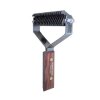I have an Aussie mix and his coat is a lot of work; basically, house-work to keep up with the shedding. I don't know that I would get a dog with a coat like his again. Some Aussies have pretty long coats, and while these make matting more likely, they may not get the same degree of shedding that shorter-coated (sometimes called a working coat) Aussies do. My dog's coat is flatter but still double coated, and he has a big shed-season once it starts getting warmer. Even if I brush once a week, I've got a house full of dog tumble-weeds :-( and his fur is over everything. I have to put a cover on the couch, and keep a sheet over the quilt on the bed because his fur really sticks. My late dog's fur was shorter and not as soft, so it could be brushed off pretty easily; Calvin's can't.
I'm just being honest, not trying to be a downer! The coat needs work, most of it frequent brushing, so do get the puppy used to being combed at a very early age. Also if you live in an area with ticks or foxtails, make a practice of picking through your dog's coat regularly. Aussies with longer coats can pick up debris quite easily, if you are in a wooded area, so a dog who loves to be combed is a bonus for this as well!
Re: the puppy -- I haven't followed your selection process, so just to make sure, the dog is from working lines right? These tend to be healthiest. And the parents have had both hips and elbows certified? Eyes too? Herding dogs, and esp. Aussies, are often affected by eye disease, so responsible breeders will have CERF or OFA + genetic testing of parent dogs.
Best of luck!






 .
.